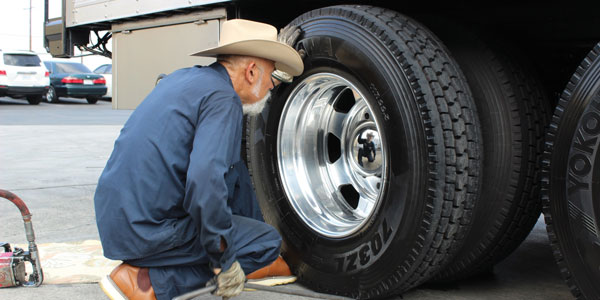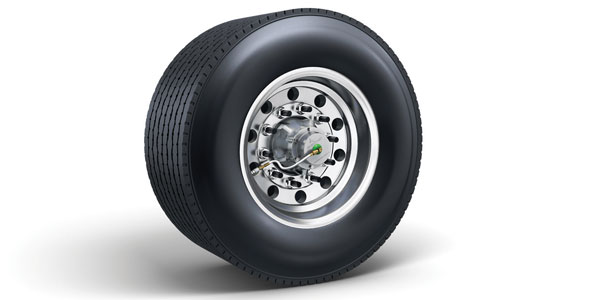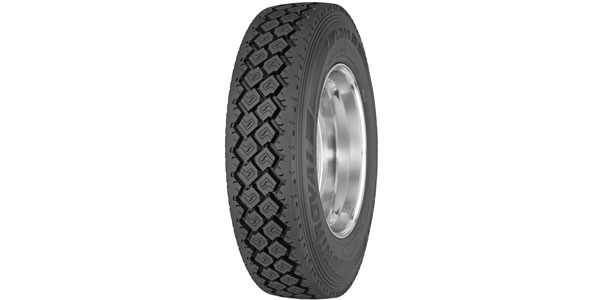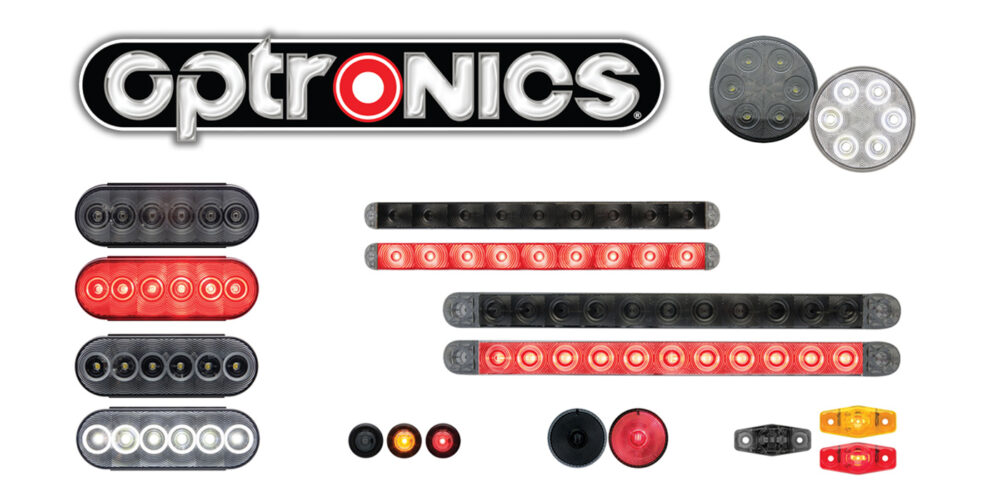A fleet manager’s job is focused on the little things. A tenth of an MPG here, an extended maintenance cycle there—across a fleet, these seemingly small points can add up to significant profits. The same goes for truck tire inflation: a few PSI in the right direction can go a long way, while a few PSI in the wrong direction is potentially disastrous. Tires are one of the most expensive components of the truck, and so the importance of keeping them in the ideal shape should come as no surprise, especially considering the substantial weight that air is supporting.
“Under-inflation is the biggest issue in the industry,” says Sharon Cowart, product marketing director for Michelin Americas Truck Tires. “It is the number one cause of premature tire removal.
“Under-inflated tires build up excessive heat that can result in tire destruction and/or improper vehicle handling,” she elaborates. “In addition, it can result in irregular wear and poor fuel economy. If a fleet invests in low rolling resistant, fuel-efficient tires and then does not maintain the optimum inflation pressure, they may not benefit from the fuel economy expected. In a similar way, tire wear is very much dependent on the tire’s footprint on the ground when running.”
Under-inflated tires will flex more than they should, and that generates excessive heat and leads to casing failure, which cripples the tire and removes any potential for retreading it.
“Very quickly, the tire becomes hot and then it eventually breaks,” explains Rick Phillips, vice president of sales for Triangle Tire USA. “This is what happens to the steel cords in the sidewall of the tire. They get hot, then weak, then they break, which can cause tire failure.”
And there’s another danger, Phillips notes. “The tires that don’t blow out are equally dangerous because they could have hidden fatigue that is easily missed,” he says.
According to the Technology & Maintenance Council (TMC) of the American Trucking Associations, a constant 20% under-inflation in a commercial vehicle tire increases tread wear by 25% and reduces the tire lifetime by 30%. This results in significant increase in tire costs for a fleet. It also increases fuel costs: under-inflation of just 10 PSI reduces fuel economy by 1%.
“The key to a good tread footprint and even tread wear is maintaining proper inflation,” says Gary Schroeder, executive director of Cooper Tire’s global truck and bus tire business. “When the tire is not contacting the road as the tire design intended, the tread area will wear irregularly, and therefore, more rapidly. The proper tire inflation figure should be determined by actual weight by axle and using a load/inflation table.”
Tire-related costs are the single largest maintenance expense item for commercial vehicle fleet operations, and improper tire inflation increases total tire-related costs by approximately $600 to $800 annually per tractor-trailer combination, according to Michelle Reinhart, Continental’s head of digital solutions for commercial vehicle tires in the Americas region.
Actually, more is less
Under-inflation may be the biggest issue in the tire industry, but don’t try to overdo it by over-filling the tires; over-inflation can also lead to some serious problems.
“Over-inflation can also ruin a perfectly good tire,” says Raul Garcia of Falken Tires commercial product planning. “The contact patch of an over-inflated tire is smaller and creates a circular patch with the road surface that greatly decreases traction and propagates irregular wear that otherwise could have been avoided.”
With summer on its way, this will be especially important to remember.
“The most common reason for over-inflation is elevated tire operating temperatures combined with increased ambient air temperature,” says Matt Wilson, Hendrickson’s controls business unit manager. “Although tires are designed to function with pressure variations from warming during normal use, pressure effects resulting from ambient temperature fluctuations are a different story.”
Additionally, Wilson says that trailer tires in a dual configuration are intended to share the load equally. They should be the same size and diameter and have the same tread pattern. Equal inflation pressure is optimal, but tire manufacturers recommend that they are within 5 PSI of each other at most.
According to Michelin’s Cowart, an inflation pressure mismatch of greater than 5 PSI will result in the two tires of a dual assembly being significantly different in circumference, resulting in irregular wear and potentially leading to eventual tire loss due to premature casing fatigue. A difference of 5 PSI between steer tires, meanwhile, will cause the vehicle to pull to the side with the lower pressure.
“I believe having a well-synchronized air pressure maintenance program between your drivers and your shop should be the single most important element of your tire policy and is really the easiest to administer,” says Matthew Hanchana, sales technical service manager for Giti Tire USA. “It has the biggest impact on your fleet costs associated with tires, including fuel consumption, wear life and irregular wear.”
TPMS and ATIS
So not too much, not too little—you’re looking for a Goldilocks-like “just right” amount of inflation for your tires. This can be difficult to monitor and stay on top of on your own, both for drivers and for fleets, which is why several digital solutions are available to achieve that delicate balance.
“Monitoring tire pressure manually is inconvenient,” Continental’s Reinhart says. “Think about it: there are 18 tires per vehicle in most cases. Even if it only takes 60 seconds to take the valve cap off, measure the pressure, and replace the valve cap on each tire, that’s almost 20 minutes of time out of the driver’s day; not to mention the time to refill the low tires. So we find that many people use the ‘thump and go’ method, which is not reliable. Even manual pressure gauges aren’t always accurate. Installing a digital tire monitoring system might have an up-front cost, but it reduces tire costs almost immediately.”
There are two types of digital tire monitoring systems: tire pressure monitoring systems (TPMS) and automatic tire inflation systems (ATIS). The difference between them is that TPMS monitor tire inflation, alerting drivers and fleets if it becomes too low or too high, while ATIS take it a step further and inflate the tire automatically in the event that it is needed.
See our comprehensive overview of the various TPMS and ATIS offerings here.
What should drivers know?
If you install TPMS or ATIS on your fleet, educating your drivers on the system will be very important, as it will be up to the driver to react if the sensors show that something is wrong.
“The purpose of TPMS in a vehicle is to warn the driver that at least one or more tires are significantly under-inflated, possibly creating unsafe driving conditions,” says Timothy Netzel, senior marketing manager for GCR Tires and Service. Netzel adds that GCR recommends that drivers also assess tire pressure themselves each day before driving, in addition to using TPMS.
Even if you are using ATIS, which automatically fill the tires when under-inflated, educating drivers on the meanings of the various sensor lights is still important.
ATIS typically come with an indicator light to show when the tires are being inflated.
“Like any new technology, drivers need to be aware of the nuances that result from their application,” says Al Cohn, director of new market development and engineering support for Pressure Systems International (P.S.I.). “If the light comes on when hooking a tractor to a trailer, it may only mean that the tires are being ‘topped off,’ and depending on how low it takes, it may not be of concern. However, a light that illuminates during a trip typically means that one of the tires has picked up a puncture and requires attention. The driver should always find a safe place to pull over and inspect the tires and determine what action to take. In many cases, they can simply continue their run and alert their maintenance people of the tire event.
“In extreme cases, such as a sidewall tear, they may need to know how to isolate the affected tire or turn off the system until the tire can be repaired or replaced,” he adds.
According to Hendrickson, if the light on the company’s Tiremaax Pro stays on for more than 10 minutes, they recommend that the driver pull over at a safe location and look for a potential leak.
Seeing ROI
So you may be thinking, “that all sounds great, but will I see ROI on this? And how soon?” Most providers of TPMS and ATIS say that fleets will see ROI very soon after spec’ing, if not immediately.
To address that ROI question, Velociti recently announced that it is teaming with Meritor for a payment program to be offered with the Meritor Tire Inflation System (MTIS). Dubbed the Instant ROI program, it will provide fleets with the ability to retrofit existing trailers with the MTIS, offering deferred billing and an extended payment plan, with no investment up front until the installation is done.
“Velociti’s 12 to 36 month extended payment terms allow fleets to maximize savings,” said Deryk Powell, president of Velociti. “This ensures that the fleet is achieving and sustaining positive cash flow from ATIS before paying a dime.”
“Every fleet is different, but some of our customers have identified enough flat or under-inflated tires immediately upon installing a Continental tire monitoring system to justify the cost,” Continental’s Reinhart said. “One road failure can cost the equivalent of three months of ContiConnect monitoring, which tracks tire pressure for all vehicles in the fleet terminal, whether it’s trucks or buses. For long haul fleets, one road failure can cost the equivalent of an entire ContiPressureCheck TPMS, our single vehicle monitoring solution.”
“A TPMS can also show its value over an extended period of time,” notes Eric Witty, vice president of product for PeopleNet. “Proper tire pressure plays an important role in maximizing miles per gallon (MPG) and tire life for individual vehicles and across an entire fleet. A TPMS gives the visibility needed to ensure that ideal pressure is achieved to lower fuel costs and reduce unnecessary tire wear.”
“TPMS and ATIS help the driver maintain proper air pressure,” says Juan Britos, senior technical services specialist at Hankook Tire. But he cautions that they do not replace proper air checks. That said, ROI can be seen almost immediately, Britos says, thanks to fewer failures and reduced need for maintenance.
“These systems are very helpful and will start to provide an ROI as soon as they are installed on the equipment; in many cases they can prevent failures before they happen,” Triangle Tire’s Phillips points out. “But just like the tires they protect, this equipment needs periodic maintenance as well.”

















